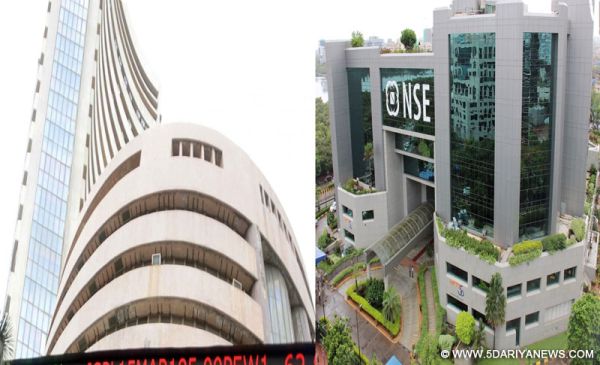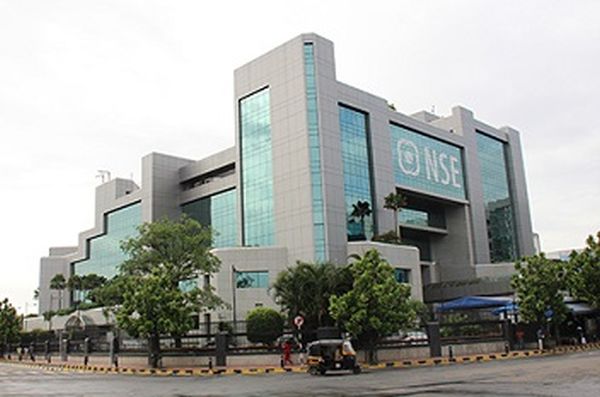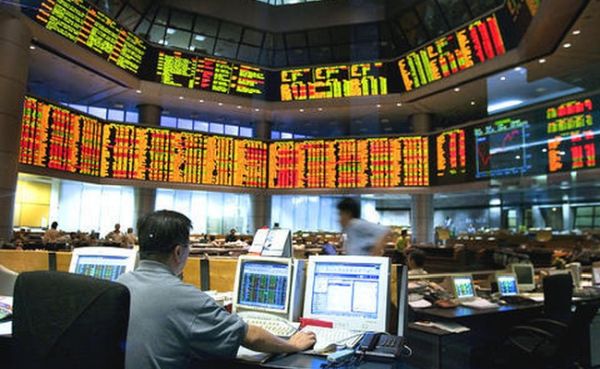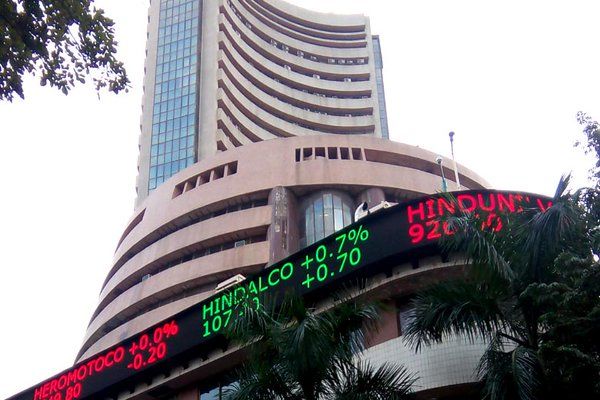
by Editor | May 25, 2021 | Banking, Economy, Markets, News
 Mumbai : Latest global trade protectionist measures, along with high crude oil prices and a depreciation in rupee’s value, dragged the Indian equity market in the red for a second consecutive session on Tuesday.
Mumbai : Latest global trade protectionist measures, along with high crude oil prices and a depreciation in rupee’s value, dragged the Indian equity market in the red for a second consecutive session on Tuesday.
Sector-wise, heavy selling pressure was witnessed in the interest sensitive stocks like banking, auto and capital goods.
Index-wise, the wider NSE Nifty50 provisionally closed at 11,278.90 points, lower by 98.85 points or 0.87 per cent from the previous close of 11,377.75 points.
The S&P BSE Sensex, which had opened at 37,660.19 points, provisionally closed at 37,290.67 points, lower by 294.84 points or 0.78 per cent from the previous close of 37,585.51 points.
It touched a high of 37,745.44 points and a low of 37,242.85 during the day’s trade.
“Carrying on from Monday, markets continued to dive on Tuesday to close in the red for the second consecutive session. The Nifty had in fact opened on a positive note, but selling soon resumed and pulled the index lower,” said Deepak Jasani, Head of Retail Research, HDFC Securities.
“The weakness came on the back of rising global trade tensions after (US President Donald) Trump said he will impose tariffs on an additional $200 billion worth of Chinese imports, escalating the trade conflict.”
According to Vinod Nair, Head of Research, Geojit Financial Services: “Selling pressure increased on the bourses due to spike in oil prices led by factors like implication of US sanction on Iran and supply constraints.
“Domestic triggers failed to add momentum despite ease in inflation, government policies to contain CAD and consolidation in PSUBs. This situation will ease once the global bond and currency market stabilise which is currently under pressure given the chaos over oil and Fed rate hike.”
On the currency front, the Indian rupee closed at 72.98, weakening 47 paise from its previous close of 72.51 per greenback.
Investment-wise, provisional data with the exchanges showed that foreign institutional investors sold scrip worth Rs 1,143.73 crore and domestic institutional investors bought stocks worth Rs 264.66 crore.
Sector-wise, only FMCG stocks on the BSE ended in the green, gaining 102.11 points.
On the other hand, the S&P BSE banking index lost 510.20 points, the auto index was down 353.54 points and the capital goods ended 250.56 points lower from its previous close.
The top gainers on the Sensex were Hindustan Unilever, up 3.87 per cent at Rs 1,666.15; Yes Bank, up 1.43 per cent at Rs 323.15; Wipro, up 1.02 per cent at Rs 332.50; ONGC, up 0.93 per cent at Rs 173.35; and ITC, up 0.23 per cent at Rs 302.60 per share.
The losers were State Bank of India, down 4.06 per cent at Rs 274; Tata Motors, down 3.36 per cent at Rs 251.45; Bajaj Auto, down 2.84 at Rs 2,775.90; Axis Bank, down 2.81 per cent at Rs 608.45; Tata Motors(DVR),down 2.45 per cent at Rs 137.55 per share.
—IANS

by Editor | May 25, 2021 | Economy, Markets, News
 Mumbai : Amid negative global cues along with a depreciating rupee, the key equity indices closed over a per cent lower on Monday after two consecutive positive sessions.
Mumbai : Amid negative global cues along with a depreciating rupee, the key equity indices closed over a per cent lower on Monday after two consecutive positive sessions.
Reports that the US might impose fresh tariffs on China weighed down the global market sentiments.
Further, weakening of the rupee during the day, despite the government announcing measures to arrest the fall of rupee in the weekend, dampened domestic sentiments.
Index-wise, the Nifty50 of the National Stock Exchange (NSE) closed at 11,377.75 points, lower by 137.45 points or 1.19 per cent from its previous close of 11,515.20 points.
The barometer S&P BSE Sensex, which had opened at 38,027.81 points, closed at 37,585.51 points, lower by 505.13 points or 1.33 per cent from its previous close of 38,090.64 points.
It touched an intra-day high of 38,027.81 points and a low of 37,548.93 points.
In the broader markets, the S&P BSE Mid-cap declined by 0.76 per cent and the S&P BSE Small-cap ended 0.05 per cent lower from its previous close.
The BSE market breadth was bearish with 1,441 declines against 1,282 advances. The total number of stocks traded on the exchange was 2,914, with 191 ending unchanged.
The weakness came on the back of weak global cues amid reports US could soon announce a new round of tariffs on Chinese imports, said Deepak Jasani, Head of Retail Research, HDFC Securities.
Major Asian markets closed on a negative note and European indices like FTSE 100, DAX and CAC 40 traded in the red, he said.
On the currency front, the Indian rupee slipped below the 72-mark again, to close at 72.51, weakening 66 paise from its previous close of 71.85 per greenback on Friday.
Investment-wise, provisional data with the exchanges showed that foreign institutional investors sold scrip worth Rs 106.54 crore and domestic institutional investors sold stocks worth Rs 180.36 crore.
Sector-wise, only three indices on the BSE ended in the green, with marginal gains. The S&P BSE realty index gained 28.03 points, the power index rose 2.86 points and the utilities index gained just 0.81 points.
On the other hand, the S&P BSE banking index lost 330.74 points, the consumer durables index was down 259.43 points and the auto index ended 243.10 points lower from its previous close.
The top gainers on the Sensex were Power Grid, up 0.70 per cent at Rs 201.50; Tata Consultancy Services, up 0.40 per cent at Rs 2,071.60; Adani Ports, up 0.37 per cent at Rs 381.45; IndusInd Bank, up 0.07 per cent at Rs 1,875; and Tata Steel, up 0.05 per cent at Rs 615.65 per share.
The losers were Sun Pharma, down 2.85 per cent at Rs 646.15; HDFC, down 2.47 per cent at Rs 1,878.60; Tata Motors, down 2.35 at Rs 260.20; Tata Motors(DVR), down 2.15 per cent at Rs 141.00; Relaince Industries, down 2.12 per cent at Rs 1,226.25 per share.
—IANS

by Editor | May 25, 2021 | Banking, Economy, Finance, Markets, News
 By Rohit Vaid,
By Rohit Vaid,
Mumbai : The Central government’s measures to arrest the drastic fall in rupee are expected to steer the equity market trajectory next week.
In addition, market observers opined that high crude oil prices along with global cues on trade protectionist measures will impact investors’ risk-taking appetite.
However, a positive reaction is expected from investors on the various measures announced by Finance Minister Arun Jaitley to curb the widening current account deficit, besides a policy to limit non-essential imports and to encourage exports.
The Minister had said the government is committed to maintain its fiscal deficit target even as it monitors the impact of external factors on the Indian economy.
Devendra Nevgi, Founder and Principal Partner, Delta Global Partners, said: “Next week’s sentiment would be dominated by the announcements made by the government to rein in current account deficit and encourage foreign flows.
“Measures taken, though not drastic, would have a soothing effect on the INR sentiment in the short term… but would not open the floodgates for foreign flows.”
In recent days, geo-political developments over trade protectionist measures along with high crude oil prices and outflows of foreign funds have pulled the Indian rupee to fresh record intra-day and closing lows.
“Despite sharp fall in rupee and consolidation in domestic markets, we are outperforming other emerging markets. The reasons for this are revival in domestic earnings growth, better economic data and softening of CPI,” said Vinod Nair, Head of Research at Geojit Financial Services.
“However, some risk factor like surge in oil prices, strengthening of dollar and escalation of trade wars are creating headwinds for the markets. Considering this, market is expected to be volatile in the near term. For the week ahead, markets will closely monitor the outcome of economic review meeting this weekend.”
Last week, the Indian rupee touched a fresh low of 72.91 a US dollar. However, towards the end of the week it recovered to close at 71.85 on Friday, weaker by 12 paise from its previous week’s close of 71.73 per greenback.
“Unless some fresh measures are announced next week, risk remains that rupee can depreciate once again. The just announced measures, though are significant in streamlining inflows through the respective markets, will do little to help the rupee right now,” said Anindya Banerjee, Deputy Vice President for Currency and Interest Rates with Kotak Securities.
“Rupee will be driven by trend of EM currencies against USD, oil prices and RBI intervention. We expect volatility to increase and a wide range of 71.50 to 73 is expected over next week.”
Besides, the direction of foreign fund flows is likely to impact the trajectory of equity market.
In terms of investments, provisional figures from the stock exchanges showed that foreign institutional investors sold scrip worth Rs 2,291.87 crore in the past week.
Figures from the National Securities Depository (NSDL) suggested that foreign portfolio investors (FPIs) divested Rs 3,076.38 crore, or $424.03 million, in the equities segment during the week ended September 14.
On technical levels, the underlying intermediate trend of the National Stock Exchange (NSE)’s Nifty50 “remains up”.
“Technically, while the Nifty has corrected this week, the intermediate trend of the Nifty remains up,” said Deepak Jasani, Head of Retail Research for HDFC Securities.
“The uptrend is likely to resume once the immediate resistance of 11,760 points is taken out. Crucial supports to watch on the downside are at 11,431-11,250 points.”
On a weekly basis, persistent depreciation in the Indian rupee along with high crude oil prices pulled the domestic equity market lower for the second consecutive week.
Consequently, the barometer S&P BSE Sensex closed at 38,090.64 points, lower 299.18 points or 0.77 per cent from its previous close.
Similarly, the wider Nifty50 on the National Stock Exchange on Friday ended at 11,515.20 points, down 73.9 points or 0.63 per cent from the previous week’s close.
(Rohit Vaid can be contacted at rohit.v@ians.in)
—IANS

by Editor | May 25, 2021 | Economy, Finance, Markets, News
 Mumbai : A recovery in the Indian rupee’s value along with broadly positive global cues and a slower rise in wholesale price inflation for August pushed the Indian equity indices higher on Friday.
Mumbai : A recovery in the Indian rupee’s value along with broadly positive global cues and a slower rise in wholesale price inflation for August pushed the Indian equity indices higher on Friday.
Consequently, the S&P BSE Sensex was up by 0.99 per cent and the NSE’s Nifty5O ended 1.28 per cent up from its previous close.
Index-wise, the Nifty50 of the National Stock Exchange (NSE) closed at 11,515.20 points, higher by 145.30 points or 1.28 per cent from its previous close of 11,369.90 points.
The barometer S&P BSE Sensex, which had opened at 37,939.29 points, closed at 38,090.64 points, higher by 372.68 points or 0.99 per cent from its previous close of 37,717.96 points.
It touched an intra-day high of 38,125.62 points and a low of 37,859.52 points.
In the broader markets, the S&P BSE Mid-cap rose by 1.62 per cent and the S&P BSE Small-cap ended 1.38 per cent higher from its previous close.
The BSE market breadth was bullish with 1,811 advances against 850 declines. The total number of stocks traded on the exchange was 2,831, with 170 ending unchanged.
“The gains came on the back of positive global cues. The sentiment was also buoyed after data showed inflation eased in August, thereby increasing the likelihood that the RBI will not increase interest rates in October,” said Deepak Jasani, Head of Retail Research at HDFC Securities.
According to Vinod Nair, Head of Research, Geojit Financial Services: “Ease in inflation and recovery in rupee added optimism in the market.”
“Stability in yield and rupee will be crucial for the market momentum while investors have continued to stay cautious due to global triggers. The global peers also traded on a positive note in expectation of ease in trade tensions between US and China. Any redressal in tensions will provide enough headroom for the domestic market.”
On the currency front, the Indian rupee closed at 71.85, recovering 34 paise from its previous close of 72.19 per greenback.
Investment-wise, provisional data with the exchanges showed that foreign institutional investors bought scrip worth Rs 1,090.56 crore and domestic institutional investors bought stocks worth Rs 115.14 crore.
Sector-wise, all the indices closed in the green. The S&P BSE consumer durables index gained 458.43 points, the banking index gained 363.38 points and the metal index was up by 311.52 points from its previous close.
The top gainers on the Sensex were Vedanta, up 5.25 per cent at Rs 235.50; Power Grid, up 3.57 per cent at Rs 200.10; Asian Paints, up 3.04 per cent at Rs 1,331; NTPC, up 3 per cent at Rs 175; and Yes Bank, up 2.75 per cent at Rs 323.10 per share.
The losers were Coal India, down 1.42 per cent at Rs 277.30; Infosys, down 1.01 per cent at Rs 735.20 per share.
—IANS

by Editor | May 25, 2021 | Economy, Markets, News
 By Rohit Vaid,
By Rohit Vaid,
Mumbai : The upcoming macro-economic data points on industrial production and inflation, along with the escalation in US-China trade war, are expected to determine the trajectory of key Indian equity indices next week.
According to market observers, factors such as global crude oil prices, combined with the rupee’s movement against the US dollar and the direction of foreign fund flows, will also impact investors’ risk-taking appetite.
Investors are expected to closely follow the macro-economic data points such as the IIP (Index of Industrial Production) and Balance of Trade figures.
The Central Statistics Office (CSO) is slated to release the macro-economic data points of IIP and CPI (consumer price index) on September 12, Wednesday.
“Next week is loaded with macro-data releases such as IIP, CPI, WPI (Wholesale Price Index) and, more importantly, the trade deficit for August. The CPI release would influence the next RBI (Reserve Bank of India) moves in the month of October,” Devendra Nevgi, Delta Global Partners Founder and Principal Partner, told IANS.
Besides macro-data, escalation in global trade protectionist measures, as well as high crude oil prices are expected to exert pressure on the Indian rupee in the coming week. Any further depreciation in the rupee’s value is expected to have a negative impact on the domestic indices.
Anindya Banerjee, Deputy Vice President for Currency and Interest Rates with Kotak Securities, said the Indian rupee is expected to remain under pressure as the US dollar could rise after US jobs data “surprised positively”.
“At the same time, US President has hinted at fresh set of tariffs on China. Both these news items can drive rupee lower. We expect a range of 71.60-72.60 on spot,” Banerjee told IANS.
The Indian rupee breached the 72 per US dollar-mark for the first time during the week ended on Friday.
The rupee ended the week at 71.73 to a USD — 73 paise weaker from its previous corresponding close of 71 per greenback.
“The currency has depreciated by 13 per cent YTD, while the 10-year yield has breached the eight per cent-mark during the week. Given these factors and the widening fiscal deficit, RBI is likely to consider a hike in interest rate in the near future,” said Vinod Nair, Head of Research at Geojit Financial Services.
“Additionally, investors will be keen on the upcoming CPI inflation and US unemployment data to get some cues on market direction.”
In terms of investments, provisional figures from the stock exchanges revealed that foreign institutional investors sold scrips worth Rs 789.60 crore and the domestic institutional investors bought stocks worth Rs 1,167.85 crore in the past week.
Technical charts showed that National Stock Exchange (NSE) Nifty50’s intermediate trend remains bullish.
“Technically, while the Nifty has corrected this week, the intermediate trend of the Nifty remains up,” said Deepak Jasani, Head of Retail Research for HDFC Securities.
“The uptrend is likely to resume once the immediate resistance of 11,760 points is taken out. Crucial supports to watch on the downside are at 11,393-11,340 points.”
Last week, depreciation in the rupee’s value and high crude oil prices dragged the Indian equity market lower.
Accordingly, the S&P Bombay Stock Exchange (BSE) Sensex closed at 38,389.82 points, lower 255.25 points or 0.66 per cent from its previous close.
Similarly, the wider NSE Nifty50 closed lower. It ended at 11,589.10 points, down 91.4 points or 0.78 per cent from the previous week’s close.
(Rohit Vaid can be contacted at rohit.v@ians.in)
—IANS

 Mumbai : Latest global trade protectionist measures, along with high crude oil prices and a depreciation in rupee’s value, dragged the Indian equity market in the red for a second consecutive session on Tuesday.
Mumbai : Latest global trade protectionist measures, along with high crude oil prices and a depreciation in rupee’s value, dragged the Indian equity market in the red for a second consecutive session on Tuesday.



